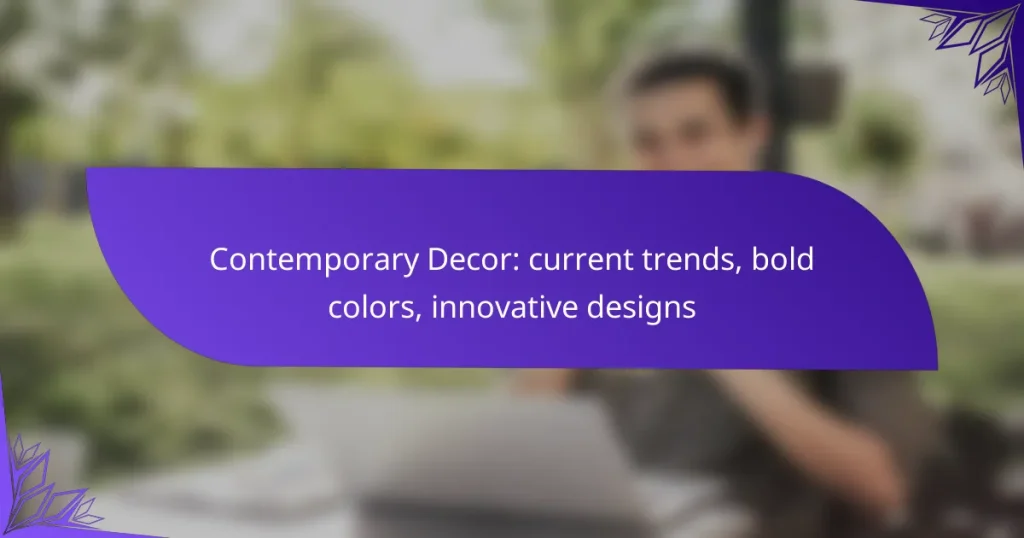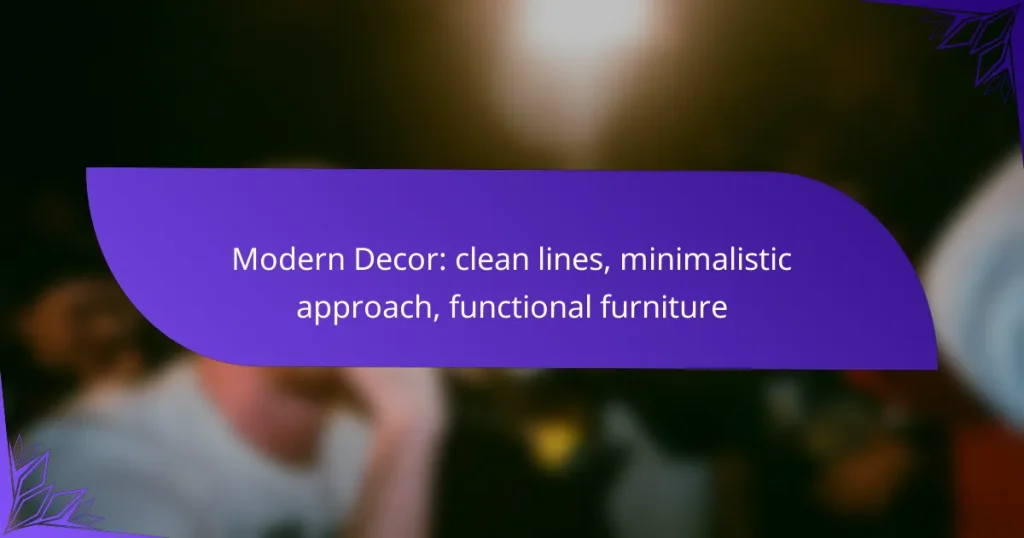Choosing the right home decor style is essential for creating a space that reflects your personality and meets your needs. With a variety of popular styles such as Modern, Rustic, and Bohemian, each offering unique characteristics, it’s important to evaluate your preferences and the specifics of your space. By understanding these elements, you can design a cohesive and inviting atmosphere that truly feels like home.
Eclectic Decor: mix of styles, unique pieces, personal touch
Zen Decor: calming elements, natural materials, minimalist design
Modern Decor: clean lines, minimalistic approach, functional furniture
What are the popular home decor styles in the United States?
In the United States, popular home decor styles include Modern, Rustic, Industrial, Bohemian, and Traditional. Each style has distinct characteristics that reflect different aesthetics and preferences, allowing homeowners to choose a look that resonates with their personal taste.
Modern
Modern decor emphasizes clean lines, minimalism, and a neutral color palette. This style often incorporates materials like glass, metal, and wood, creating a sleek and uncluttered look. Key elements include open spaces, functional furniture, and a focus on natural light.
When adopting a modern style, consider investing in statement pieces that serve both form and function. Avoid overcrowding spaces with unnecessary decor to maintain the airy feel typical of modern design.
Rustic
Rustic decor draws inspiration from nature and rural settings, featuring natural materials like wood, stone, and leather. This style often includes warm, earthy colors and handmade elements, creating a cozy and inviting atmosphere. Key features may include exposed beams, vintage furniture, and organic textiles.
To achieve a rustic look, incorporate reclaimed wood furniture and accessories that showcase craftsmanship. Balance rustic elements with modern touches to prevent the space from feeling outdated or overly traditional.
Industrial
Industrial decor is characterized by its raw, unfinished look, often showcasing elements like exposed brick, metal fixtures, and concrete. This style emerged from repurposed warehouses and factories, emphasizing functionality and simplicity. Color schemes typically include grays, blacks, and browns.
When designing an industrial space, consider using open shelving and vintage lighting to enhance the aesthetic. Mixing in softer textures can help soften the harshness of industrial materials, creating a more balanced environment.
Bohemian
Bohemian decor is vibrant and eclectic, reflecting a carefree lifestyle. This style incorporates a mix of colors, patterns, and textures, often featuring global influences and handmade items. Key elements include layered textiles, plants, and unique art pieces.
To create a Bohemian space, focus on layering different fabrics and incorporating various cultural artifacts. Avoid strict color schemes; instead, embrace a mix that feels personal and inviting.
Traditional
Traditional decor is rooted in classic design principles, featuring rich colors, elegant furnishings, and ornate details. This style often includes symmetrical layouts, antique furniture, and decorative moldings, creating a timeless and sophisticated look. Common materials include wood, silk, and wool.
When opting for a traditional style, choose quality pieces that reflect craftsmanship. Incorporate family heirlooms or antiques to add character and a sense of history to your space.
How to choose the right home decor style for your space?
Choosing the right home decor style involves understanding your preferences, the characteristics of your space, and your financial limits. By evaluating these factors, you can create a cohesive and inviting atmosphere that reflects your personality and meets your needs.
Assess your personal taste
Your personal taste is the foundation of your home decor style. Consider what colors, patterns, and materials resonate with you. Look through design magazines or online platforms like Pinterest to gather inspiration and identify styles that appeal to you.
Make a list of your favorite decor elements, such as rustic wood, sleek metal, or vibrant textiles. This will help you narrow down your options and create a style that feels authentic to you.
Evaluate your space
Understanding the layout and features of your space is crucial in choosing a decor style. Take note of the size, shape, and natural light in each room. For instance, a small room may benefit from a minimalist style to avoid feeling cluttered.
Consider the architectural details of your home as well. A modern home may lend itself to contemporary decor, while a vintage property might be better suited for classic or eclectic styles. Use your space’s strengths to guide your choices.
Consider your budget
Your budget will significantly impact your home decor decisions. Determine how much you are willing to spend on furniture, accessories, and renovations. This will help you prioritize your purchases and avoid overspending.
Look for budget-friendly options like thrift stores or online marketplaces for unique finds. Additionally, consider investing in a few key pieces that can elevate your decor, while opting for more affordable items for accessories and smaller furnishings.
What are the key elements of modern home decor?
Modern home decor is characterized by its emphasis on simplicity, functionality, and a clean aesthetic. Key elements include sleek lines, a neutral color palette, and minimalist furnishings that together create a harmonious and uncluttered environment.
Sleek lines
Sleek lines are a hallmark of modern decor, emphasizing straight, clean edges and geometric shapes. This design choice creates a sense of order and sophistication, making spaces feel more open and airy. When selecting furniture or decor, look for pieces that feature smooth, uninterrupted lines.
To achieve a cohesive look, consider incorporating furniture with angular designs or accessories that highlight linear forms. Avoid overly ornate or intricate details, as they can detract from the modern aesthetic.
Neutral color palette
A neutral color palette is essential in modern home decor, often featuring shades of white, gray, beige, and black. These colors provide a calming backdrop that allows other design elements to shine without overwhelming the space. When choosing your color scheme, aim for a balance of light and dark tones to add depth.
To enhance the neutral palette, consider adding texture through materials like wood, metal, or textiles. This approach keeps the space visually interesting while maintaining the serene vibe typical of modern decor.
Minimalist furnishings
Minimalist furnishings are crucial in modern home decor, focusing on essential pieces that serve a purpose without excess. This means selecting furniture that is functional yet stylish, often with multi-use capabilities. For example, a coffee table with storage can help maintain a clutter-free environment.
When furnishing your space, prioritize quality over quantity. Invest in a few key pieces that reflect your style and can withstand the test of time, rather than filling the room with numerous items that may not be as meaningful or useful.
How does rustic decor differ from traditional decor?
Rustic decor emphasizes a natural, unrefined aesthetic, while traditional decor focuses on classic elegance and symmetry. Rustic styles often feature raw materials and a cozy, lived-in feel, contrasting with the polished finishes and formal arrangements typical of traditional designs.
Natural materials
Rustic decor prominently features natural materials such as wood, stone, and metal. These elements create an organic feel, often incorporating reclaimed or distressed items that add character. In contrast, traditional decor may use more refined materials like polished woods and fine fabrics, emphasizing craftsmanship and elegance.
When selecting materials for a rustic space, consider items like rough-hewn beams, stone fireplaces, and handmade pottery. These choices not only enhance the aesthetic but also promote sustainability by using locally sourced or recycled materials.
Warm color tones
Warm color tones are a hallmark of rustic decor, often incorporating earthy hues like browns, greens, and deep reds. These colors evoke a sense of warmth and comfort, making spaces feel inviting and cozy. Traditional decor, on the other hand, may utilize a broader palette, including cooler tones and more vibrant colors, often in a more structured manner.
To achieve a rustic look, opt for paint or textiles in warm shades that mimic the natural environment. Think about using terracotta, mustard yellow, or forest green to create a harmonious and welcoming atmosphere. Avoid overly bright or stark colors that can disrupt the cozy vibe characteristic of rustic design.
What are the benefits of mixing decor styles?
Mixing decor styles can create a unique and personalized living space that reflects your individual taste. It enhances the overall aesthetic by combining different elements, resulting in a more dynamic and visually appealing environment.
Personalized aesthetic
By blending various decor styles, you can curate a space that truly represents your personality. For example, combining modern furniture with vintage accessories allows you to showcase your love for both contemporary design and nostalgia. This approach can help you avoid the cookie-cutter look often seen in homes that adhere strictly to one style.
To achieve a personalized aesthetic, consider selecting key pieces that resonate with you and harmonizing them through color and texture. Aim for a cohesive look by using a consistent color palette or similar materials across different styles.
Enhanced visual interest
Mixing decor styles adds depth and intrigue to your home, making it more inviting and engaging. A well-executed combination can draw the eye and encourage exploration of the space. For instance, pairing rustic elements like reclaimed wood with sleek metal accents can create a striking contrast that captures attention.
To enhance visual interest, focus on layering different textures and shapes. Use a mix of patterns, such as geometric prints alongside floral designs, to create a balanced yet exciting environment. Be mindful of not overcrowding the space; instead, allow each piece to shine while contributing to the overall harmony.
What decor items are essential for a cohesive look?
To achieve a cohesive home decor style, essential items include furniture, textiles, lighting, and accessories that complement each other. These elements should share a common theme, color palette, or design style to create a unified appearance throughout your space.
Furniture
Furniture is the foundation of your decor style. Choose pieces that align with your chosen theme, whether it’s modern, rustic, or traditional. For example, a mid-century modern sofa can set the tone for a contemporary living room, while a farmhouse dining table can enhance a cozy, rustic vibe.
Consider the scale and proportion of your furniture in relation to the room size. Oversized furniture can overwhelm a small space, while tiny pieces may get lost in a larger room. Aim for a balanced arrangement that promotes flow and functionality.
Textiles
Textiles, including rugs, curtains, and cushions, add warmth and texture to your decor. Select fabrics that harmonize with your color scheme and overall style. For instance, soft, neutral fabrics can create a serene atmosphere, while bold patterns can add visual interest.
Layering textiles can enhance depth and comfort. Combine different materials, such as a plush area rug with cotton throw pillows, to create a welcoming environment. Be mindful of maintenance; choose fabrics that are easy to clean and durable for high-traffic areas.
Lighting
Lighting plays a crucial role in setting the mood and highlighting your decor. Incorporate a mix of ambient, task, and accent lighting to create a well-lit space. For example, a statement chandelier can serve as a focal point, while table lamps provide functional light for reading or working.
Consider the color temperature of your bulbs; warmer tones can create a cozy feel, while cooler tones may enhance a modern aesthetic. Dimmer switches can also offer flexibility, allowing you to adjust the lighting according to the time of day or occasion.
Accessories
Accessories, such as artwork, plants, and decorative objects, add personality to your home. Choose items that reflect your interests and style, ensuring they complement the overall decor. A carefully curated gallery wall can showcase your taste, while indoor plants can bring life and color to a room.
Be cautious not to overcrowd surfaces with too many accessories. Aim for a balanced arrangement that allows each piece to shine. A good rule of thumb is to use the “three-item rule” for tabletop displays, creating visual interest without clutter.



